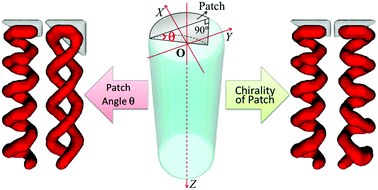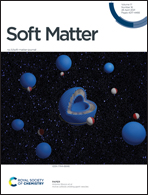Controlling the chirality and number of strands of helices self-assembled from achiral block copolymers confined inside a nanopore: a simulation study†
Abstract
Achiral block copolymers can self-assemble into helical structures when confined inside a cylindrical nanopore. However, controlling the chirality and the number of strands of helices is challenging. We present our simulation results of the influence of a chiral patch added to the confining nanopore on the structures and chirality of helices self-assembled from achiral cylinder-forming diblock copolymers under the confinement. Our results indicate that, when the designed patch is of proper geometry, it can induce the formation of helical structures and exhibit good control over their chirality. The bottom surface of the patch can induce the formation of a characteristic local structure near and parallel to it. It is the characteristic local structure that directs the formation of helices and of their chirality consistent with that of the patch. A large patch angle or the top/bottom surface of a weakly selective pore promotes the formation of double-helices compared to single-helices by enlarging the pitch of the helices near the patch or through the entropic attraction of the top surface of the pore to the minority blocks.



 Please wait while we load your content...
Please wait while we load your content...